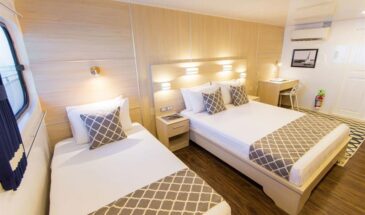- Overview
- Trip Outline
- Trip Includes
- Gallery
- Reviews
- Booking
- FAQ
Food & Drinks
Western Food
Local Food
Vegetarian Options
Snacks All Day
Vegan Options
Welcome Cocktails
Full-board Option
If you have any specific dietary requirements whilst on-board your cruise, you can add this to your special requests
Day 1
- AM: Arrival at Baltra Airport
Upon arrival at Baltra Airport, you will first pass through an airport inspection point where your TCT (Transit Control Card) will be checked and stamped (please keep this carefully with your passport as you will need to show it again when you leave Galapagos). Here you will also pay the Galapagos National Park entrance fee of USD 100 (unless it has been prepaid). To ensure that no foreign plants or animals are introduced to the islands, your luggage will be inspected as well. At the arrival hall, a naturalist guide will meet you and escort you on a short bus ride to the harbor at Baltra. By dinghy, you will be taken to the yacht. - PM: Mosquera
Mosquera Islet is located between Baltra and North Seymour. This is a small islet formed by a geological uplift, with a reef of rocks and coral and a great white sand beach, where a population of sea lions can be found. You can also observe several species of shorebirds. Along the rocks are commonly running Red Lava crabs or Sally light-foot crabs.
Day 2
- AM: Darwin Bay (Genovesa)
This bay has origin when the crater of this island collapsed below sea level. The wet landing is on a beautiful white coral sandy beach. This is a favorite island for birdwatchers: red footed-boobies, masked boobies, wandering tattlers, lava gulls, whimbrels Yellow-crowned, black-crowned and lava herons, and yellow warblers can be seen in the area.
Continuing on the trail, visitors climb gradually to the edge of the cliff seeing Red-Foots nesting in the Mangrove trees below. Bird watching includes sightings of Sharp-Beaked Finches, Large Cactus and Ground Finches, Galapagos Doves and Swallow-Tailed Gulls. Reaching the end of the trail at the cliff's edge offers an incredible view of the island and the many birds living there. - PM: Prince Phillip Steps (Genovesa)
El Barranco is located in the southern part of Darwin Bay and it is also known as Prince Philip’s Steps. Passengers will climb to a plateau that is part of the stretch of land that surrounds Darwin Bay on its eastern side. There is a big population of Masked boobies and Red-Footed boobies in the trees; Storm petrels and Short-eared Owls have found the ideal place for nesting in the lava flows.
Day 3
- AM: Plazas
South Plazas is located at the east of Santa Cruz Island and forms part of two islands known as Islas Plazas. Despite its small size, some of the most interesting and outstanding species of the Galapagos are found here. The Plazas land iguanas are smaller than their relatives found on other islands. Throughout the island there are several hybrid iguanas, a result of crossing a male marine iguana and a female land iguana, they are unique, recognizable at first glance by their black/gray color, with a land iguana's crest, but face and tail of the marine iguana. The big population of iguanas is due to the presence of tunas, their favorite food. Swallow-tailed Gulls nesting in the rugged cliffs is seen along with other sea birds as Audubon shearwaters, red-billed tropicbirds, frigate birds, and brown pelicans. - PM: Santa Fe
Located in the southeastern part of the Galapagos, this island was formed from an uplift, which explains why it is mostly flat. There are some theories that assure this could be the oldest island in the Archipelago. Santa Fe is the home of a number of endemic species like the Galapagos Hawk, Galapagos snake, Galapagos mockingbird, rice rats, and one of the two species of lands Iguanas of the islands. After disembarkation in the beautiful and clear waters, you will be in contact with one of the many sea lion colonies. Along the trail, many salt bushes can be seen as well as giant prickly pear cactus. There are great possibilities of snorkeling with playful sea lions and tropical fishes.
Day 4
- AM: Leon Dormido
This huge ‘cathedral’ of rock is an old lava cone, now split in two. On the rocks, many blue-footed boobies, Nazca boobies, and frigate birds are to be found. The snorkeling is great here, with good opportunities for seeing sea turtles, spotted eagle rays, tropical fish, and the Galapagos shark. - Transfer to San Cristobal airport for your flight back to Guayaquil or Quito.
Please note that the itineraries are examples only, We reserve the right to change the itinerary or specific agreed services, if force majeure, unforeseen or unavoidable circumstances require us to do so.
snacks, tea and coffee on the boat
Wet suit, mask and fins
Bilingual guide Spanish / English
Shared boat for sightseeing
Arrival / departure transfersLunch,
No Details Found
















There are no reviews yet.